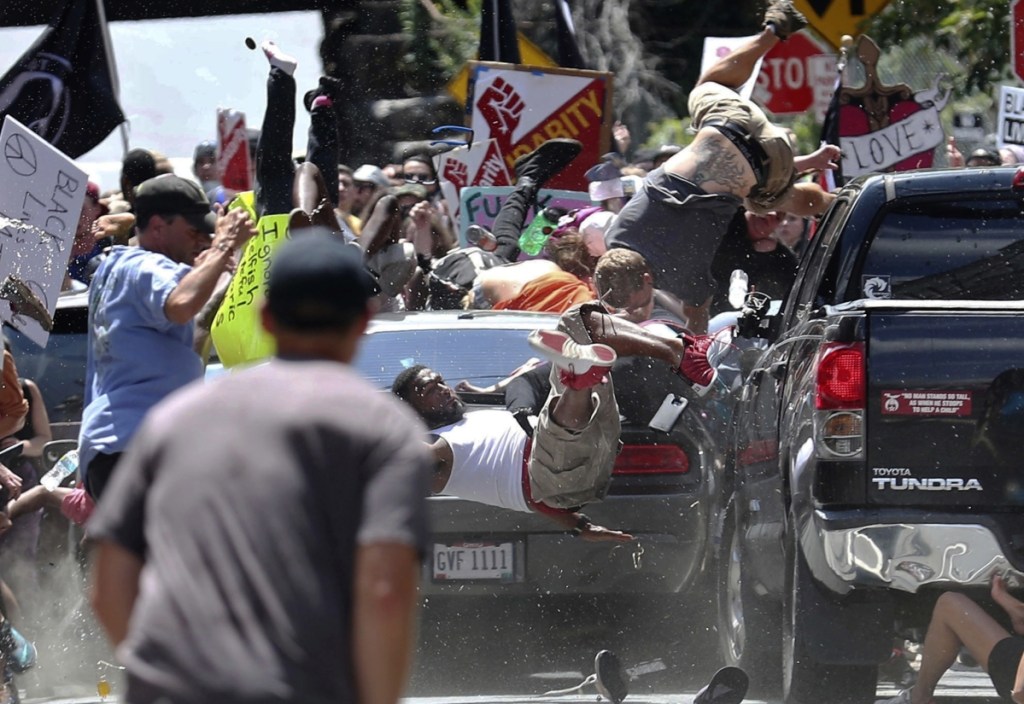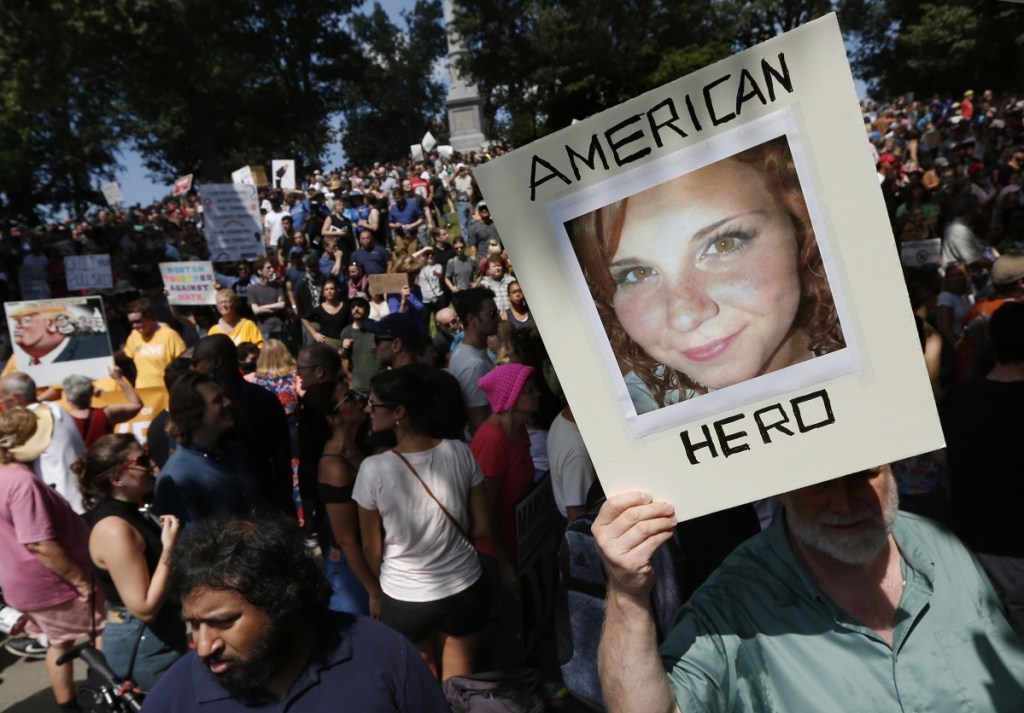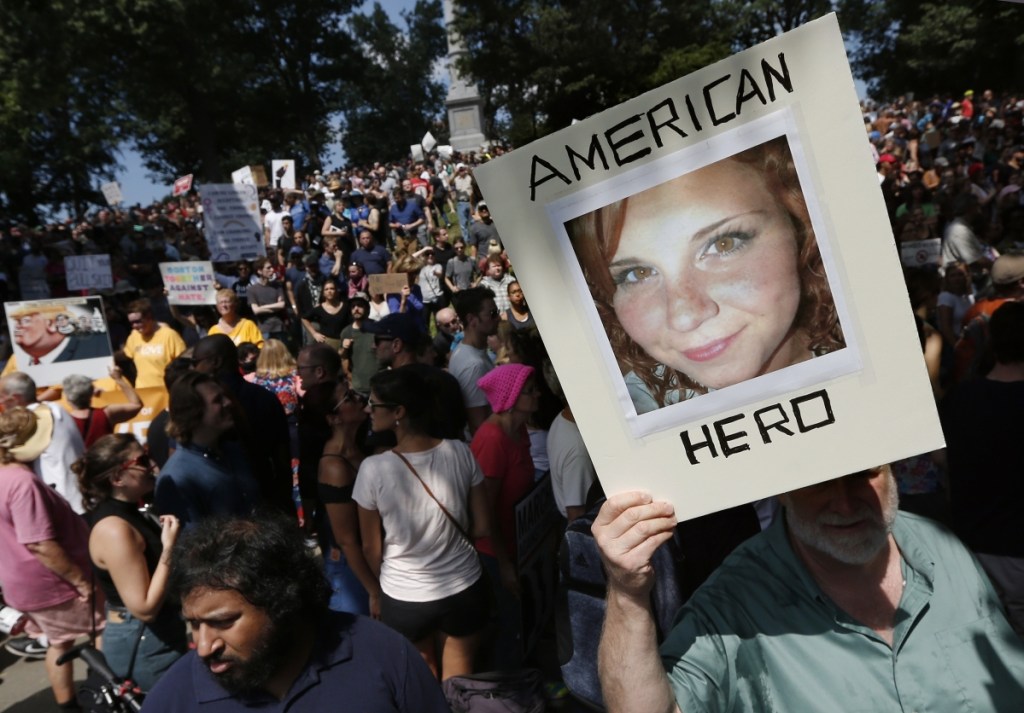CHARLOTTESVILLE, Va. — In May 2017, three months before he rammed his speeding Dodge Challenger into a group of counterprotesters during a violent white supremacists rally here, self-professed neo-Nazi James Fields Jr. posted photos on Instagram of “a car running into a crowd of people,” a prosecutor revealed in court Thursday.
As Fields’ murder trial got underway after three days of jury selection, Assistant Commonwealth’s Attorney Nina-Alice Antony said the prosecution would prove that Fields acted with premeditation, an essential element of the first-degree murder charge against him. “This isn’t about what he did,” she told the panel in her opening statement, noting that Fields does not deny driving into the crowd. “It’s about what his intent was.”
One of Fields’ attorneys, in his opening remarks, said the defense would show that Fields acted out of fear of the counterprotesters and not with criminal malice.
“This is not a whodunit case,” lawyer John Hill told the jury, acknowledging that Fields, now 21, “operated his motor vehicle in a such a way as it caused a death and some serious injuries.” He was referring to counterprotester Heather Heyer, 32, who was killed, and 35 surviving victims who were hurt, several of them grievously.
Although he did not mention “self-defense” in his opening statement, and he did not specify why his client was purportedly in fear before the crash, Hill earlier told prospective jurors, “There will be evidence that (Fields) took these actions in an attempt to defend himself.”
Antony, in focusing her remarks on premeditation, seemed to expect that the central issue in the trial will be Fields’ state of mind on Aug. 12, 2017, the day of the rally.
The first victim to testify Thursday, Marcus Martin, sobbed on the witness stand in Charlottesville Circuit Court as he described pushing his then-fiancee, Marissa Blair, out of the path of the oncoming Challenger. Blair and Heyer were friends who worked together as paralegals at a local law firm. Martin, who is now married to Blair, was standing with the two women in the crowd of counterprotesters in downtown Charlottesville.
“She was a great person,” Martin said of Heyer, before he broke down emotionally.
In the early afternoon that day, Fields stopped his 2010 Dodge Challenger near the crowd at 4th and Water streets. Authorities said he then backed up for more than a block before bolting forward at a high speed, crashing into another vehicle at the corner and propelling victims into the air. One of them was Martin.
“I was looking at my phone,” he told the jury. “And I hear a tire screeching. The only thing I could think about was getting my wife out of the way.”
He paused, head bowed.
“I pushed her . . . “
Antony asked, “And what happened?”
“That’s when I got hit,” said Martin, who suffered a broken shin and ankle.
Antony, in her opening, told the jury that Heyer “was not as fortunate,” that she was “hit with the full force of the Challenger” and suffered extensive internal injuries.
In a photo of the scene that circulated worldwide, Martin, then 27, clad in a white tank-top, tan cargo shorts and red-and-white sneakers, can be seen several feet in the air, his body horizontal. Photojournalist Ryan Kelly, then of the Daily Progress newspaper in Charlottesville, was awarded a Pulitzer Prize for the picture.
At the defendant’s table, Fields listened impassively, clad in dark slacks and an open-collar shirt under a Navy blue V-neck sweater. Acquaintances have said that Fields, as a teenager in Kentucky and Ohio, had long expressed admiration for the militarism and racial-purity doctrine of Nazi Germany.
Antony told jurors that Fields, who traveled to Charlottesville from his apartment in Maumee, Ohio, near Toledo, arrived in the city “filled with anger” on the morning of the racist, anti-Semitic “Unite the Right” demonstration.
She said, “This case is about his decision to act on that anger” during a day of violent clashes involving hundreds of ethno-fascists and counterprotesters.
She said Fields posted the two identical photos on his Instagram account on May 12 and May 16, 2017, weeks before he drove alone to Charlottesville, an overnight trip of more than 500 miles. He brought only one change of clothes – khaki pants and a white polo shirt, the uniform of the day for white supremacists at the rally.
Hill, the defense lawyer, told jurors that when they watch videos of Fields talking with police after his arrest, they will see that he had earlier been “scared for his safety and was scared to death.” The trial, which could last until mid-December, will be about “why this event took place,” Hill said, referring to the fatal crash. At the conclusion of testimony, he said, “You’ll understand why I’m telling you now he’s not guilty.”
The hours of violence in Charlottesville that day, which climaxed with a deadly act of alleged automotive rage, stunned the national conscience and helped make “Charlottesville” a shorthand term for the emergence of emboldened white supremacists in the early months of the Trump administration.
In addition to first-degree murder, punishable by up to life in prison, Fields is charged with five counts of aggravated malicious wounding and three counts of malicious wounding related to eight of the 35 injured people.
The second victim to testify, Brian Henderson, in his 40s, said he had nowhere to run as Fields’ vehicle came barreling toward him – so he leaped, hoping he would roll over the hood of the speeding car.
“I’m breaking left,” he said. “At this point, I took flight as best I could. I threw up my arms like Superman … and I closed my eyes.” Like Martin, Henderson choked back tears as he described his injuries: All of the toenails on one foot were torn off, and his left arm was so badly broken that he still suffers numbness and weakness.
He told the jury: “I just wasn’t fast enough that particular day.”
Send questions/comments to the editors.





Success. Please wait for the page to reload. If the page does not reload within 5 seconds, please refresh the page.
Enter your email and password to access comments.
Hi, to comment on stories you must . This profile is in addition to your subscription and website login.
Already have a commenting profile? .
Invalid username/password.
Please check your email to confirm and complete your registration.
Only subscribers are eligible to post comments. Please subscribe or login first for digital access. Here’s why.
Use the form below to reset your password. When you've submitted your account email, we will send an email with a reset code.